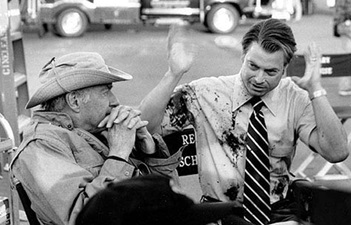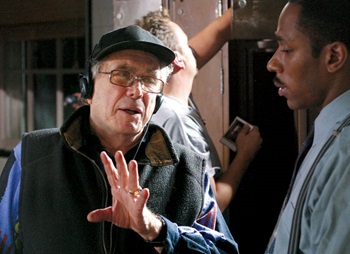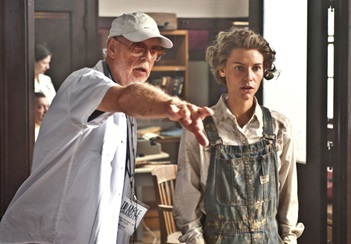Untitled Document
By Robert Abele
Since their inception in the early 1960s, original movies for television have carved out a special niche in the programming landscape. Ubiquitous throughout the ’70s and ’80s, the best of them could reach extraordinary heights of intelligence, storytelling, and artistic distinction. Although they don’t dominate the airwaves as they once had, in the last two decades made-for-television movies have showcased the remarkable maturity and breadth of the genre. This is partly due to the emergence of cable TV’s less-constricting standards, but it’s more from the efforts of a wide range of talented directors. We’ve reached a time in television when the artistic strides of episodic series have been met by the quality and distinction of their feature-length brethren. These are not just good made-for-television movies—they’re good movies period. And fortunately, most of them are available on DVD.

There was a homey sturdiness to the made-for-TV movie as it was still known to viewers in the ’90s. While HBO was beginning to feel its oats as a movie powerhouse with such offbeat originals as Brian Gibson’s The Josephine Baker Story (1991), the Hallmark Hall of Fame brand was still television’s gold standard for emotionally resonant storytelling safe for beaming into every home: heartwarming, well-acted, and guaranteed to draw tears. Glenn Jordan’s 1991 ratings smash for Hallmark, Sarah, Plain and Tall—about a grieving 19th century Midwestern family’s growing bond with their father’s new mail-order bride from New England—exemplified the kind of mass appeal TV film that could wring emotion. Viewed today it still retains its quiet power to transport us to a time of prairie toil, perseverance, and simple pleasures. Jordan’s expert framing of the characters—played memorably by Glenn Close and Christopher Walken—against open, outdoor spaces, or shrouded by darkly lit interiors gives the film its unexpected weight as a heartland yarn.
The measured accruing of character details and situations toward a big emotional payoff in Sarah was typical of the best TV movies in a time when outsize emotion often reigned. But certain directors knew how to agitate the small screen from scene one, and perhaps no director in television was better at relentless tension than John Frankenheimer. His pioneering work staging live dramas in the golden age of TV goes without saying, but it was the urgency of his ’60s political/historical feature films—The Manchurian Candidate (1962), Seconds (1966), Birdman of Alcatraz (1962)—that he memorably conjured when he returned to television in the 1990s. Building on the TV success of his Attica Prison film Against the Wall (1994, HBO), the Chico Mendes story The Burning Season (1994, HBO), and his epic Civil War saga Andersonville (1996, TNT), Frankenheimer next turned to George Wallace (1997, TNT) and produced a bold, unvarnished, and multifaceted look at Alabama’s notoriously segregationist politician that stands as one of the medium’s great biopics. In covering elections won and lost, and the emotional fallout from the assassination attempt on Wallace, Frankenheimer memorably plunders the gray area where populism and political opportunism created a local hero but a national scourge. Frankenheimer’s camera gets so close to the faces of his actors—a fierce Gary Sinise as Wallace, the great Mare Winningham and a vivacious, young Angelina Jolie as his first and second wives, respectively—that it becomes a lab experiment of sorts: Can we see what made these people tick? Frankenheimer doesn’t shy away from the period’s ugly racism, but he also isn’t afraid to find the tragedy in a man so beholden to winning power that he sabotages his soul.
Oddly enough, George Wallace was a rare dramatized glimpse at the civil rights era from the perspective of white authority, because a significant characteristic of the made-for-television movie in the last two decades was an emphasis on the struggles of African-Americans, told from their viewpoint. Robert Markowitz’s dramatization of an all-black World War II fighting unit The Tuskegee Airmen (1995, HBO),and biopics such as Julie Dash’s The Rosa Parks Story (2002, CBS) and Martha Coolidge’s Introducing Dorothy Dandridge (1999, HBO) were just a handful of the noteworthy television films that shone a necessary spotlight on players in American history routinely ignored by Hollywood’s feature industry. These films drew top-drawer talent to the small screen—Laurence Fishburne, Angela Bassett, Halle Berry—that only further enhanced the cachet of the genre.
HBO delved often into movies about the African-American past, including the standout Boycott (2001). Clark Johnson’s re-creation of the 1955 bus boycott in Montgomery, Alabama, that kicked off the modern civil rights movement is a marvel of historical subjectivity with a contemporary feel. Combining varying visual styles (black and white and color, newsreel footage alongside grainy handheld dramatizations, fourth-wall-breaking testimonials) and a suspenseful narrative, Johnson gives a gritty, prismatic view of a then-uncertain, hotly debated movement that could have fallen apart at any time, but gloriously didn’t. Jeffrey Wright’s mesmerizing portrait of Martin Luther King Jr. isn’t that of a man destined for greatness but of a natural leader with a tough-as-nails job: negotiating with city officials and his own constituency, holding off despair, inspiring his flock, and assessing threats. The way Boycott handles a citywide issue with a steady accumulation of personal, cultural, and political details hints at the directorial signature Johnson would bring a year later to the trailblazing, novelistic series The Wire.

Boycott benefited by bringing an edgy, fresh approach to an easily lionized time. In other cases, the pocket of history being brought to life was unknown enough that a steady, assured storytelling hand was needed, as was the case with three-time DGA Award-winning director Joseph Sargent’s Something the Lord Made (2004, HBO). The television movie veteran’s achingly compassionate rendering of the mutually trusting yet socially fraught professional relationship between storied heart surgeon Alfred Blalock (Alan Rickman) and his gifted but underappreciated black lab technician Vivien Thomas (Mos Def), who together pioneered open-heart surgery in the 1940s, is made all the more powerful by what Sargent avoids as much as focuses on. Setting aside the easy schmaltz of ignoring racism in the pursuit of medical miracles, Sargent, known for his handling of sensitive material (the deafness drama Love Is Never Silent from 1985 and the 1997 Tuskegee Experiment story Miss Evers’ Boys), pushes for a more complex study of careerism and vocational happiness. In an unforgettable scene notable for the pungent dissipation it brings to the normally discomfort-averse inspirational-movie genre, Thomas quits his beloved job, revealing to Blalock the woundedness he felt over being left out of the doctor’s public statements of gratitude. “We changed the world,” Blalock implores, a big-picture plea to a man who feels like a cameo in his own story. “I’m invisible to the world,” Thomas replies, Mos Def giving the words a weary acceptance. “I thought it was different in here.”
The disillusionment and heartache underneath the most public of lives is what makes the expansive biopic Life with Judy Garland: Me and My Shadows (2001, ABC), directed by Robert Allan Ackerman (The Reagans, 2003), an unnervingly poignant experience. Adapted from Garland’s daughter Lorna Luft’s memoir of her mom’s turbulent life, it has the distinction of simultaneously feeling like a whirlwind and a nightmare, thanks to Ackerman’s tantalizing re-creation of studio system glamour and the grim off-camera dramas of addiction, manipulation, and insecurities that fueled it. It’s all anchored by a string of fine performances, most notably Judy Davis’ towering central turn as Garland in all her star wattage and jittery vulnerability. Ackerman clearly went for layered characterization over easy impersonation.
Bringing real people to small-screen life has always been a dicey proposition, with television movies garnering a not-undeserved reputation for capitalizing too quickly on sensational headlines—how many Amy Fisher movies were there, exactly? But the success of Michael Ritchie’s wry, psychologically astute The Positively True Adventures of the Alleged Texas Cheerleader-Murdering Mom (1993, HBO) showed that “based on a true story” didn’t have to feel cheap and exploitative. And in the case of actress-turned-director Betty Thomas’ smart, funny, and lightning-paced inside-showbiz film The Late Shift (1996, HBO)—about network television’s scheming to find a replacement for Johnny Carson—it could even feel slyly illuminative. Deftly orchestrating this boardroom farce replete with seductive power players, insecure talent, protective screamers, and double-dealing executives, Thomas takes unrepentant pleasure in the behavioral nastiness of this behind-the-curtain material (adapted from the acclaimed book by New York Times journalist Bill Carter). But the touches of humanity, most notably in the break between Jay Leno (Daniel Roebuck) and his bridge-burning manager Helen Kushnick (a fiery Kathy Bates), also suggest how tough it often is to reconcile ambition with loyalty in the cutthroat world of entertainment.

Of the leading lights in made-for-television movies these last two decades, four-time DGA Award winner Mick Jackson has shown a particularly keen understanding of media-related stories. His nervy Indictment: The McMartin Trial (1995, HBO) made stellar visual use of the claustrophobic scrums of news reporters outside of courtrooms to heighten the narrative tension of a trial that lasted years, and he brought the bluster and comic verve of old school journalism movies to the story of the CNN reporters who covered the start of Operation Desert Storm in Live from Baghdad (2002, HBO).
Both of those films dealt with overcoming insurmountable odds. But it’s the particular triumph of Jackson’s Temple Grandin (2010, HBO)—starring Claire Danes as the real-life autistic woman whose special affinity for the behavioral psychology of animals led her to groundbreaking work in their ethical treatment—that makes it perhaps his masterpiece, and a new high watermark for the television film. On the surface it’s a life-affirming portrait of an outcast’s self-actualization, yet it bypasses nearly all the clichés associated with sappy affliction dramas. Instead it fairly saturates the viewer’s consciousness with the visual and aural signposts of a differently wired brain of a woman who is looking for ways to assert herself in the world. As Grandin hears turns of phrase that don’t make sense to her (“rising with the roosters”), we get quick flashes of the oddball literal images she sees (someone on a roof with a rooster). When a routine daily occurrence like eating at a school cafeteria triggers her over-sensitivity to sound, Jackson turns up the volume on the scene’s environment and edits together close-up shots of their sources (shouting chefs, clanging plates) so that we understand this overpowering source of discomfort. It’s never an overly aggressive stylistic choice, however, but always in the service of connecting us emotionally to someone who for the community of autistics and their caregivers was one of the first able to effectively communicate how her condition affected her. Working in tandem with Danes’ impressively mannered eccentricities of voice and physicality, Jackson produced an essential work of empathy, struggle, and understanding worthy of the medium’s unique intimacy.
Movies such as Temple Grandin, Something the Lord Made, and the others mentioned here may be watched in homes instead of given the grand treatment of a theatrical presentation for large crowds, but they still illustrate what’s essential about the medium of film, no matter how they’re seen: They reach, they connect, and they endure.